Why are so many UX Designers former musicians?
Starting with the great Jeff Gothelf, I noticed a pattern of musicians switching careers into UX Design. I participate in a number of slack communities, which typically include a channel specifically for introductions where people state their name, location, and former occupation. Although not the majority of people by far, a surprising amount of people state their former occupation as “musician”. What is causing people to put down their guitars, step away from the mixing consoles, and become UX Designers?
An outlet for self expression
I can picture myself ten years ago alone in a cramped Tokyo apartment, feverishly practicing guitar etudes 6 hours a day with dreams of going to Berklee. I was in a band who wanted me to save or take out $10,000 in loans to tour the country without any label backing (I’m so glad I didn’t do that). Although with each year that passes my glasses become a little more rose-colored, I look back on those days as happy times. I was expressing myself.
Today, when I look at my collection of artboards on Sketch I feel a similar sense of satisfaction that only comes when creating something or expressing oneself artistically.
But “Wait!” you say, “UX Design isn’t about self expression”! “We align stakeholder, business and user needs and objectives”! Very true. However I would argue that many, if not most musicians do the same thing. The wedding guitarist who goes out and plays cover tunes every weekend, the sound engineer who produces other people’s songs, the drum tech who tunes the snare each night for someone else to play, aren’t these people still musicians? We can’t all be Lady Gaga. I feel the same satisfaction aligning objectives to turn ideas into a great product like how a producer feels when they export that final mix.
Why UX Design specifically?
I love all areas of design. However certain fields have a higher barrier of entry than others. I don’t know many self taught or bootcamp industrial designers. Starting graphic design in your 30’s would put you at a significant disadvantage to the 22 year olds just graduating with a portfolio they poured years of work into.
UX Design/ Product Design/ Human Centered Design is still a relatively new field. We still can’t even decide on a proper job title yet. Although UX Design as a major has become more popular in recent years, it’s still rare to find someone with a specific degree in it.
By comparison, even the big names in UX Design came from other fields. You probably noticed that many of the senior level people out there came from a graphic design background, although that is changing these days. I think it’s a great thing. A lot of people complain about “gatekeeping” in the industry, and securing your first junior role in UX is going to be easier said than done, but compared to other fields I find UX to be very welcoming.
Parallels to music
“The notes you don’t play are just as important as the notes you do”.
I find the concept of negative space to be similar to empty space in music. “The notes you don’t play are just as important as the notes you do”. The clean, minimalistic style of flat design is similar to how simplicity and repetition makes a great pop song. Color theory has certain parallels to musical harmony. Visual hierarchy has a connection to dynamics. If you can operate a full featured DAW for music production, learning how to use Sketch won’t be that much of a jump.
Of course while huddled over practicing scales in my apartment 10 years ago I never thought much about typography or column layouts, but learning the fundamentals of design has opened up a whole new world to me that was right in front of my eyes the entire time. It’s the same feeling I got when taking music theory courses in college.
Keep on rockin’
For any musicians changing fields into UX, I welcome you with open arms. I will also passionately argue with you about how the 1975’s style of vocal production is the best thing ever, how the Lydian mode is the best mode, and how Mesa Boogie amps are the only option for any serious metal guitarist. But in all seriousness, the field has a lot to benefit from diverse backgrounds and perspectives and us musicians have a lot to offer. Welcome to the UX club.








